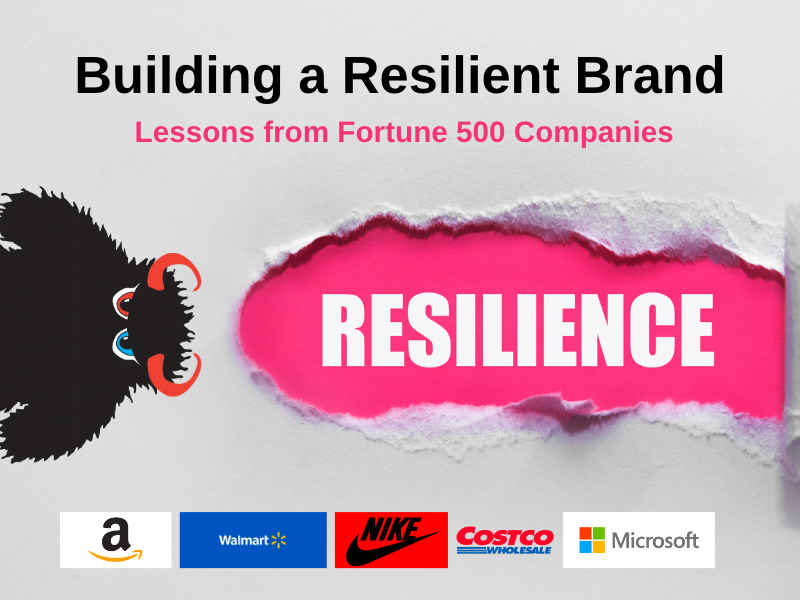
Building a resilient brand has become more critical in today’s rapidly evolving business environment. Brand resilience refers to a brand’s ability to withstand various forms of crisis, from economic downturns to reputational challenges. This resilience allows companies to maintain brand equity and customer loyalty, even in adversity. Fortune 500 companies, with their vast resources and experiences, often serve as practical case studies for understanding how to build and maintain a resilient brand.
Understanding Brand Resilience: A Crucial Asset in Times of Crisis
Brand resilience is not just about surviving a crisis but thriving amidst it. A brand can bounce back stronger after a setback, leveraging the crisis as a learning opportunity to reinforce its brand values. A resilient brand is often characterized by strong customer loyalty, positive brand perception, and the capacity to adapt and respond to market or external environment changes quickly.
Strategies for Building a Resilient Brand
Maintaining Consistent Communication: An Essential Strategy – In the face of adversity, maintaining open, transparent, and consistent communication with stakeholders is beneficial and essential. It serves multiple purposes – building and sustaining trust, reassuring customers, employees, and shareholders, and ensuring everyone is on the same page about the company’s responses and strategies.
For instance, during the COVID-19 pandemic, many companies faced unprecedented challenges. Amidst the global crisis, companies like Microsoft and Amazon stood out for their effective communication strategies. They made it a point to regularly update their stakeholders about their steps to protect their employees and customers, manage operational disruptions, and adapt to the new normal.
Microsoft, for example, kept its stakeholders informed through regular updates on its website, detailing the measures they were implementing to support remote work, ensure the safety of its employees, and maintain service delivery to customers. They also communicated their initiatives aimed at supporting communities affected by the pandemic.
Similarly, Amazon regularly updated its stakeholders about its efforts to maintain operations while ensuring the safety of its workers and customers. They communicated policy changes, such as modified delivery processes, increased warehouse health and safety measures, and initiatives to support employees and communities.
Expanding Communication Channels – Consistent communication is not just about providing updates. It also involves actively listening to stakeholders and addressing their concerns. In this digital age, companies can leverage various channels – such as corporate websites, emails, social media platforms, virtual meetings, and webinars – to facilitate two-way communication. These platforms can gather feedback, understand stakeholder concerns, and respond promptly.
Moreover, effective communication should also involve a level of empathy. Particularly in crisis, stakeholders appreciate when companies acknowledge the challenges and express genuine concern for their well-being. This can significantly enhance the company’s reputation and strengthen its stakeholder relationships.
Consistent communication is critical to crisis management and brand resilience. By maintaining regular, transparent, and empathetic communication, companies can effectively manage crises, build stronger relationships with stakeholders, and enhance brand resilience.
Staying True to Core Values: The Apple Story
A brand’s core values are its guiding principles, dictating its actions, strategies, and corporate decisions. These are the fundamental beliefs a brand promises to uphold—their commitment to the customers. One company that stands as a testament to this strategy is Apple Inc., a Fortune 500 company known globally for its strong and resilient brand.
Apple’s core values revolve around innovation, simplicity, and excellent customer experience. These values are deeply ingrained in their products, marketing strategies, and customer service. This has created a unique brand identity that people recognize and associate with high-quality, innovative technology.
During times of crisis or market volatility, Apple’s commitment to its core values never wavered. Let’s consider the period following the 2007-2008 financial crisis. Despite the challenging economic environment, Apple continued to invest in innovation. In 2007, they launched the first iPhone, and in 2010 the first iPad was introduced. These innovative products didn’t just reinforce Apple’s brand image as an innovator and revolutionized the tech industry.
This unwavering commitment to core values has been critical in maintaining Apple’s strong brand image. Even in the face of competitive pressures and market changes, Apple’s core values of innovation, simplicity, and user-centricity remain unchanged, solidifying its position in the minds of consumers.
Through their actions, Apple has demonstrated that staying true to brand values is not just about making an ideological stand. It directly contributes to brand resilience, successfully enabling the company to navigate challenging times while strengthening customer loyalty and trust.
Embracing Agility
Agility is a crucial characteristic of resilient brands. The ability to quickly adapt to changes and pivot strategies as needed can help companies navigate crises effectively. An example is how Netflix shifted from DVD rentals to streaming services in response to technological changes and consumer preferences.
Investing in Customer Relationships: Learning from Walmart and Costco
Building and maintaining strong customer relationships is crucial to brand resilience. This strategy goes beyond merely providing products or services to customers—it involves understanding their needs, preferences, and expectations and consistently meeting or exceeding them. Brands that prioritize customer relationships invest in customer satisfaction and strive to deliver an exceptional customer experience at every touchpoint. This customer-centric approach builds loyalty and trust, which can prove invaluable in times of crisis.
Consider the examples of Walmart and Costco, two Fortune 500 companies that have demonstrated the power of investing in customer relationships, particularly during the COVID-19 pandemic.
When the pandemic hit in early 2020, it led to unprecedented disruption in the retail industry. Many businesses had to close their physical stores due to lockdowns and social distancing measures, leading to a massive shift towards online shopping. Amid these challenging circumstances, both Walmart and Costco leveraged their strong customer relationships to adapt quickly and effectively.
Recognizing the changing needs of their customers, Walmart and Costco significantly expanded their online and delivery services. They offered curbside pickup and same-day delivery options, enabling customers to shop safely from their homes. These efforts were about maintaining sales and clearly demonstrated their commitment to serving their customers’ needs during a difficult time.
By putting customers at the forefront of their response to the crisis, Walmart and Costco strengthened their customer relationships further. The increased convenience and safety measures were appreciated by customers, leading to increased customer loyalty and trust. As a result, both companies saw substantial growth in their online sales during the pandemic.
This example underlines the importance of investing in customer relationships to build brand resilience. Companies that put their customers first understand their needs, and adapt accordingly can survive crises and emerge stronger.
Case Study: Nike’s Brand Resilience
Nike is an excellent example of a Fortune 500 company with a resilient brand. Despite various challenges over the years, from economic downturns to reputational issues, Nike has managed to maintain its strong brand image. This resilience can be attributed to several factors:
- Commitment to Innovation: Nike has consistently invested in innovation, both in terms of its products and its marketing strategies. This commitment has helped the company stay relevant and ahead of its competitors.
- Strong Brand Identity: Nike has a clear and compelling brand identity that resonates with its target audience. The company’s brand values of performance, innovation, and inspiration are reflected in everything it does, from its products to advertising campaigns.
- Customer-Centric Approach: Nike strongly emphasizes understanding and meeting its customers’ needs. The company regularly conducts market research to gain insights into customers’ preferences and uses them to inform its product development and marketing strategies.
- Effective Crisis Management: Nike has shown an ability to effectively manage crises and mitigate their impact on its brand image. This includes taking swift and decisive action, communicating transparently with stakeholders, and learning from these experiences to prevent future crises.
Building Resilience: A Continuous Process
Building a resilient brand is not a one-time effort but a continuous process. It involves persistent efforts to enhance and protect the brand’s reputation, consistently deliver quality products or services, and maintain solid customer relationships. This process requires strategic thinking and the ability to adapt to changing circumstances quickly.
Take the examples of Fortune 500 companies like Nike, Apple, and Microsoft. These companies have built solid and resilient brands that have withstood various challenges. They have consistently delivered high-quality products, innovated based on customer needs and market trends, and maintained a strong customer focus. They have also demonstrated the ability to adapt and evolve in response to changing market conditions and customer preferences.
Nike, for example, has continuously innovated its products and marketing strategies to stay relevant in the competitive sportswear market. It has embraced digital transformation, leveraging technology to enhance customer experience and drive growth. Similarly, Apple’s focus on innovation and customer experience has helped it maintain its position as a leading technology brand. And Microsoft’s shift towards cloud computing demonstrates its ability to adapt and thrive in a changing business environment.
Investing in Brand Resilience: The Road Ahead
Moreover, as the business environment becomes increasingly volatile and uncertain, brand resilience will likely become an even more critical factor in a company’s success. External shocks, whether economic recessions, global pandemics, or social upheavals, can severely impact a company’s operations and bottom line. However, companies with strong, resilient brands are often better equipped to navigate these challenges and recover quickly.
Therefore, companies of all sizes and across all industries would do well to prioritize building brand resilience as a critical part of their overall business strategy. This requires a commitment to continuous improvement, a willingness to adapt and evolve, and a strong focus on maintaining positive and enduring customer relationships.
By doing so, companies can not only withstand the inevitable challenges and seize opportunities to grow and thrive in an ever-changing business landscape. A resilient brand can be a strong foundation for long-term success, providing a competitive advantage in an increasingly complex and competitive business environment.
Bringing it Home
Building a resilient brand is crucial for businesses to thrive in today’s dynamic and uncertain business environment. The lessons from Fortune 500 companies highlight the importance of maintaining consistent communication, staying true to brand values, embracing agility, and investing in customer relationships. By adopting these strategies, businesses can enhance their brand resilience and be better equipped to navigate crises, ensuring long-term success.
Throughout this ongoing journey of building brand resilience, remember this critical insight – “resilience is not merely about weathering the storm but learning how to dance in the rain.” – Vivian Greene
About Brad Nietfeldt

As one of the most sought after digital marketing gurus in America, Brad’s entrepreneurial career involves writing and producing music, successful tech start ups, working for several fortune 500 companies and in his early 20s he was of the first support staff at the then start up currently known as PayPal.com. Learn more.
Let’s Work Together
TELL ME MORE ABOUT YOUR PROJECT
Want more traffic, leads, & sales?
We work with some of the world’s biggest and most reputable brands, why not allow us to work as an extension of yours? All it takes is a few seconds and a click to start the process.